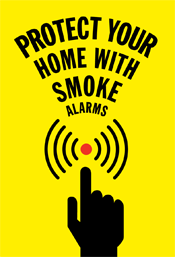Choosing your smoke alarm
How many smoke alarms

The more smoke alarms you have the safer you will be, you should have at least one alarm on each floor.
However, if you have only one alarm and two floors, put it somewhere you and your family will be able to hear it when you are asleep. If you have a TV or other large electrical appliance such as a computer in any of the bedrooms, you should fit a smoke alarm there too.
Which smoke alarm
There are a variety of models to choose from, depending on your needs and budget. This section lists the types of smoke alarm which are most commonly available.
Ionisation alarm
- These are the cheapest and most readily available.
- Are very sensitive to flaming fires that burn fiercely such as chip-pan fires.
- They will detect flaming fires before the smoke gets too thick.
Optical alarms
- These are more expensive and more effective at detecting slow-burning fires, such as smouldering foam-filled furniture or overheated wiring.
- They are less likely to go off accidentally and so are best for ground floor hallways and for homes on one level.
Which model?
A lot of people forget to test their smoke alarms. So the best choice of power supply is usually the one that lasts longest.
Whichever model you choose, you should make sure that it meets British Standard 5446, Part 1 (BS 5446-1) and ideally also carries the British Standard Kitemark.
Standard-battery alarms
- An ionisation battery alarm is the cheapest and most basic smoke alarm available.
- An optical battery alarm is a little more expensive.
- Both run off 9-volt batteries.
Battery alarms with an emergency light
- These come fitted with an emergency light which comes on when the alarm is triggered.
- They are particularly suitable if someone in your house has hearing difficulties.
Alarms with 10-year batteries
- These are slightly more expensive, but you save on the cost of replacing batteries.
- They are available as ionisation or optical alarms.
- Are fitted with a long-life lithium battery or a sealed power pack that lasts for 10 years.
Models with a ‘hush’ or ‘silence’ button
- Some models are available with a 'hush' button which will silence the alarm for a short time.
- This can be used when cooking, for example.
- If there is a real fire, giving off lots of smoke, the hush system is overridden and the alarm sounds.
- These models will continue to remind you they have been silenced by 'chirping' or by displaying a red light.
Mains-powered alarms
- These are powered by your home’s electricity supply and need to be installed by qualified electricians.
- There’s no battery to check, although they are available with battery back-up in case of a power cut.
Interconnecting or linked alarms
- Some alarms can be connected to each other so that when one senses smoke, all the alarms in the property sound.
- They are useful for people with larger homes.
We are happy to provide guidance on which alarm is best for your circumstances. If you would like assistance call our free phone our Community Safety number 08000 325999 or email: community.safety@oxfordshire.gov.uk
